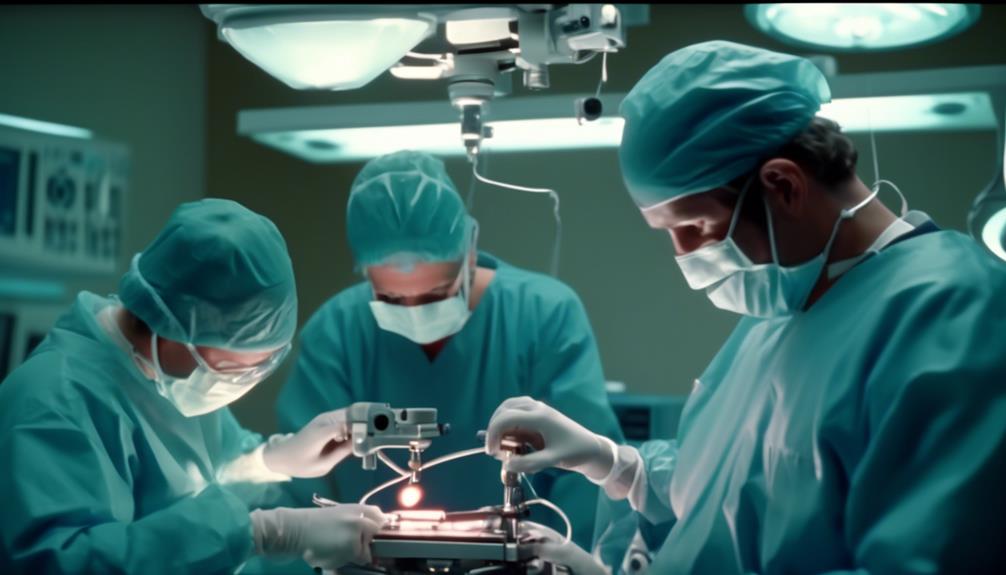First Laparoscopic Surgery (1987) – Mouret: Recap and Summary: Minimally Invasive Surgery Advance

The first laparoscopic surgery in 1987, performed by Dr. Philippe Mouret, revolutionized minimally invasive surgery. It led to shorter patient recovery times and improved precision for surgeons.
Key Takeaways
- Laparoscopic surgery revolutionized medicine with its minimally invasive technique, offering reduced pain, shorter hospital stays, and faster recovery times.
- Dr. Philippe Mouret completed the world's first laparoscopic cholecystectomy in 1987, revolutionizing surgical techniques and training.
- Minimally invasive surgeries offer faster recovery times, smaller incisions, shorter hospital stays, and less blood loss compared to open surgeries.
- Laparoscopic surgery offers enhanced precision and visualization, minimizing the risk of complications and allowing surgeons to better navigate the surgical site and identify anatomical structures.
The Birth of Laparoscopic Surgery
The birth of laparoscopic surgery revolutionized the field of medicine by introducing a minimally invasive technique for surgical procedures.
Laparoscopy, a surgical procedure in which a small incision is made and a camera is inserted into the body, has a rich history dating back to the early 20th century. However, it wasn't until the late 1980s that laparoscopic surgery truly came into its own.
French surgeon Dr. Philippe Mouret performed the first laparoscopic cholecystectomy, the removal of the gallbladder, in September 1987. This groundbreaking procedure marked a significant milestone in medical advancements.
Prior to this, traditional open surgery was the standard approach for most procedures, which often resulted in longer hospital stays, increased pain, and longer recovery times for patients. With the introduction of laparoscopic surgery, patients experienced reduced pain, shorter hospital stays, and faster recovery times.
This new technique also offered surgeons improved visualization and precision during procedures.
The birth of laparoscopic surgery paved the way for numerous advancements in the field of medicine, leading to improved patient outcomes and a greater freedom of choice for both patients and surgeons.
Dr. Philippe Mouret's Groundbreaking Achievement
After revolutionizing the field of medicine with the introduction of laparoscopic surgery, Dr. Philippe Mouret achieved a groundbreaking milestone that forever changed the way surgical procedures were performed. His achievement had a significant impact on the evolution of laparoscopy and revolutionized surgical training.
Dr. Mouret's groundbreaking achievement was the successful completion of the world's first laparoscopic cholecystectomy in 1987. This procedure involved the removal of the gallbladder through small incisions using a laparoscope, a thin tube with a camera and surgical instruments. Prior to this, cholecystectomies required large abdominal incisions and longer recovery times.
The introduction of laparoscopic surgery by Dr. Mouret not only revolutionized surgical techniques but also had a profound impact on surgical training. The minimally invasive nature of laparoscopy allowed trainee surgeons to observe and assist in procedures with greater ease. It provided a unique opportunity for trainees to develop their skills in a controlled and less invasive environment.
Furthermore, laparoscopic surgery enabled surgeons to perform procedures with greater precision and reduced pain for patients. The shorter recovery times and smaller incisions resulted in less scarring and improved patient satisfaction.
Dr. Mouret's groundbreaking achievement paved the way for the widespread adoption of laparoscopic surgery and transformed the field of surgery forever. His contribution to the evolution of laparoscopy and the impact on surgical training is immeasurable, and his pioneering spirit continues to inspire medical professionals worldwide.
Advantages of Minimally Invasive Surgeries
Minimally invasive surgeries offer several advantages over traditional open surgeries.
One major advantage is faster recovery time, as smaller incisions result in less trauma to the body.
Additionally, these surgeries often require shorter hospital stays and may allow patients to return to their normal activities sooner.
Faster Recovery Time
Patients who undergo minimally invasive surgeries can experience a significantly faster recovery time compared to traditional open surgeries. This is due to several factors that contribute to improved postoperative outcomes and reduced postoperative pain.
- Smaller incisions: Minimally invasive surgeries involve making small incisions, usually less than an inch in length. This results in less tissue damage and trauma, leading to quicker healing and reduced pain.
- Less blood loss: Compared to open surgeries, minimally invasive procedures typically involve less blood loss. This not only reduces the risk of complications but also helps patients recover faster.
- Shorter hospital stay: Minimally invasive surgeries often require shorter hospital stays, allowing patients to return to their normal lives sooner. This not only improves their overall quality of life but also reduces the financial burden associated with prolonged hospitalization.
Smaller Incisions
With smaller incisions, minimally invasive surgeries offer several advantages over traditional open surgeries.
One of the key benefits is reduced scarring. Unlike open surgeries that require large, noticeable incisions, minimally invasive procedures only require small incisions, often no more than a few millimeters in size. These smaller incisions result in minimal scarring, which can be a significant improvement cosmetically.
Additionally, smaller incisions also contribute to decreased postoperative pain. Because the incisions are smaller, there's less trauma to the surrounding tissues, leading to reduced pain and discomfort after the surgery. This allows for a faster recovery and a quicker return to normal activities.
Impact on Patient Recovery Time
The impact of laparoscopic surgery on patient recovery time has been a significant advancement in the field of surgical procedures. This minimally invasive technique has revolutionized patient outcomes and postoperative pain management.
Here are three key ways in which laparoscopic surgery has positively influenced patient recovery time:
- Reduced postoperative pain: Laparoscopic surgery involves making small incisions, resulting in less tissue trauma compared to traditional open surgery. As a result, patients experience less postoperative pain, leading to a quicker recovery and a decreased need for pain medication.
- Faster healing and shorter hospital stays: With smaller incisions, laparoscopic surgery minimizes tissue damage and promotes faster healing. This, in turn, allows patients to leave the hospital sooner and resume their daily activities more quickly, leading to a higher level of freedom and independence.
- Decreased risk of complications: The advantages of laparoscopic surgery, such as improved visualization and precision, contribute to a reduced risk of complications during and after the procedure. This means patients can recover without the added burden of potential complications, further improving their overall recovery experience.
Enhanced Precision and Visualization
Enhanced precision and visualization in laparoscopic surgery have revolutionized the field by offering improved surgical accuracy and a clearer view of anatomy.
With the use of advanced technology and specialized instruments, surgeons are able to perform procedures with greater precision, minimizing the risk of complications.
Additionally, the enhanced visualization provided by high-definition cameras allows surgeons to better navigate the surgical site and identify anatomical structures, ensuring a more successful outcome.
Improved Surgical Accuracy
How can surgical accuracy be improved through enhanced precision and visualization techniques?
There are several ways in which these techniques can contribute to improved surgical outcomes and reduced post-operative complications:
- High-definition imaging systems: Advanced imaging technologies provide surgeons with a clearer view of the surgical site, allowing for better identification of structures and more precise surgical maneuvers.
- Robotic-assisted surgery: Robotic systems offer enhanced precision and dexterity, enabling surgeons to perform complex procedures with greater accuracy and control.
- Image-guided navigation: Utilizing real-time imaging, this technique allows surgeons to navigate through the anatomy with precision, ensuring accurate placement of surgical instruments and reducing the risk of damage to surrounding tissues.
Clearer View of Anatomy
To achieve enhanced precision and visualization during surgery, surgeons can utilize advanced imaging technologies and robotic-assisted systems. These advancements provide a clearer view of the anatomy, allowing surgeons to navigate with improved accuracy and efficiency. With clearer visualization, surgeons can identify structures more easily and make precise incisions, reducing the risk of complications. This technology also enables real-time imaging, providing immediate feedback during the procedure. Additionally, the use of robotic-assisted systems enhances surgical benefits by offering increased dexterity and stability. Surgeons can manipulate instruments with greater precision, resulting in more precise suturing and reduced tissue trauma. Overall, the clearer view of anatomy provided by advanced imaging technologies and robotic-assisted systems contributes to improved surgical outcomes and patient satisfaction.
| Surgical Benefits | Enhanced precision and visualization | Reduced risk of complications | Real-time imaging | Increased dexterity and stability |
|---|---|---|---|---|
| Clearer Visualization | Yes | Yes | Yes | Yes |
| Surgical Outcomes | Improved | Improved | Improved | Improved |
| Patient Satisfaction | Increased | Increased | Increased | Increased |
Evolving Techniques and Instruments
The field of laparoscopic surgery has witnessed significant advancements in techniques and instruments, revolutionizing the way surgeries are performed. These evolving techniques and advanced equipment have greatly improved patient outcomes and recovery times. Here are three key developments in this field:
- Robotic-assisted surgery: Robotic systems, such as the da Vinci Surgical System, have been introduced to enhance laparoscopic procedures. These systems provide surgeons with enhanced precision, flexibility, and control, allowing for complex surgeries to be performed with minimal invasiveness. Robotic-assisted surgery offers improved dexterity, 3D visualization, and reduced surgeon fatigue, leading to better surgical outcomes.
- Single-incision laparoscopic surgery: Traditionally, laparoscopic surgeries required multiple small incisions. However, with advancements in instruments and techniques, single-incision laparoscopic surgery has become possible. This approach involves performing the entire procedure through a single small incision, resulting in minimal scarring, reduced pain, and faster recovery times.
- Fluorescence imaging: Fluorescence imaging techniques, such as indocyanine green (ICG) fluorescence, have been incorporated into laparoscopic procedures. By injecting a fluorescent dye into the patient, surgeons can visualize blood flow, lymphatic drainage, and tissue perfusion in real-time. This technology helps identify critical structures, improve precision, and reduce the risk of complications.
These advancements in laparoscopic techniques and instruments have revolutionized the field of surgery, allowing for safer, more precise, and minimally invasive procedures. Surgeons now have access to a wider range of tools and technologies, enabling them to provide better outcomes for their patients.
Expanding Applications of Laparoscopic Surgery
With the advancements in laparoscopic techniques and instruments, the applications of laparoscopic surgery have expanded to encompass a wider range of procedures. The development and integration of new technologies have revolutionized the field of minimally invasive surgery, allowing for the exploration of emerging procedures that were previously unimaginable.
Laparoscopic surgery is no longer limited to simple procedures like gallbladder removal or appendectomy. Surgeons are now able to perform complex surgeries such as hysterectomy, colorectal resection, and even organ transplantation using laparoscopic techniques.
The expanding technologies in laparoscopic surgery have paved the way for improved visualization, enhanced precision, and reduced invasiveness. The use of high-definition cameras, advanced imaging modalities, and robotic assistance has enabled surgeons to achieve better outcomes and faster recovery times for patients. These technological advancements have also opened doors for less invasive approaches in various specialties, such as urology, gynecology, and orthopedics.
Furthermore, emerging procedures in laparoscopic surgery include single-incision laparoscopic surgery (SILS), natural orifice transluminal endoscopic surgery (NOTES), and robotic-assisted surgery. SILS involves performing the entire surgery through a single small incision, resulting in minimal scarring and reduced post-operative pain. NOTES, on the other hand, allows surgeons to access the abdominal cavity through natural orifices such as the mouth, anus, or vagina, eliminating the need for external incisions altogether. Robotic-assisted surgery combines the precision of laparoscopic instruments with the dexterity of robotic arms, enhancing the surgeon's capabilities and expanding the possibilities of minimally invasive procedures.
Future Innovations in Minimally Invasive Procedures
Innovations in minimally invasive procedures are continually shaping the future of surgical techniques and patient care. As advancements in technology continue to unfold, the possibilities for improving surgical outcomes and patient experiences are expanding.
Here are three future technologies that hold great promise in the field of minimally invasive procedures:
- Robotic Assistance: Robotic-assisted surgery is a rapidly evolving field that combines the precision of robots with the expertise of surgeons. These systems allow surgeons to perform complex procedures with enhanced dexterity and precision, leading to better outcomes for patients. With the ability to access confined spaces and perform intricate tasks, robotic assistance is revolutionizing minimally invasive surgery.
- Telemedicine: The integration of telemedicine into minimally invasive procedures offers the potential for patients to receive expert care remotely. Through real-time video consultations and remote monitoring, patients can access specialized medical advice and follow-up care without the need for travel. This not only improves convenience but also expands access to quality healthcare, especially for those in remote or underserved areas.
- Nanotechnology: The application of nanotechnology in minimally invasive procedures holds immense potential for targeted drug delivery, precise imaging, and tissue regeneration. Nanoparticles can be engineered to selectively deliver medication to specific sites within the body, minimizing side effects and improving therapeutic efficacy. Additionally, nanoscale imaging technologies can provide highly detailed and accurate visualization, guiding surgeons during procedures. Furthermore, nanomaterials can stimulate tissue regeneration, promoting faster recovery and reducing complications.
Frequently Asked Questions
What Were the Challenges Faced by Dr. Philippe Mouret During the Development of Laparoscopic Surgery?
During the development of laparoscopic surgery, Dr. Philippe Mouret faced several challenges. These included limited visibility, difficulty in maneuvering instruments, and skepticism from the medical community. However, he persevered and made significant advancements in minimally invasive surgery.
How Has Laparoscopic Surgery Improved the Quality of Life for Patients?
Laparoscopic surgery, with its advancements in patient recovery and improved surgical outcomes, has transformed lives. The use of this technique has enhanced the quality of life for patients, allowing them to enjoy freedom from the burdens of traditional surgery.
Are There Any Potential Risks or Complications Associated With Minimally Invasive Surgeries?
Minimally invasive surgeries, like any medical procedures, carry potential complications and risks. These may include infection, bleeding, organ damage, and anesthesia-related issues. It's essential to discuss these with your surgeon to make an informed decision.
Can Laparoscopic Surgery Be Performed on All Types of Medical Conditions or Are There Any Limitations?
Laparoscopic surgery has limitations and may not be suitable for all medical conditions. However, advancements in this field have expanded its applications. It is best to consult with a healthcare professional to determine if it is the right option for your specific condition.
How Has the Field of Laparoscopic Surgery Evolved Since Its Introduction in 1987?
Since its introduction in 1987, laparoscopic surgery has evolved significantly. Techniques have evolved, thanks to advancements in technology, allowing for more precise and minimally invasive procedures. This freedom of choice has revolutionized the field.









